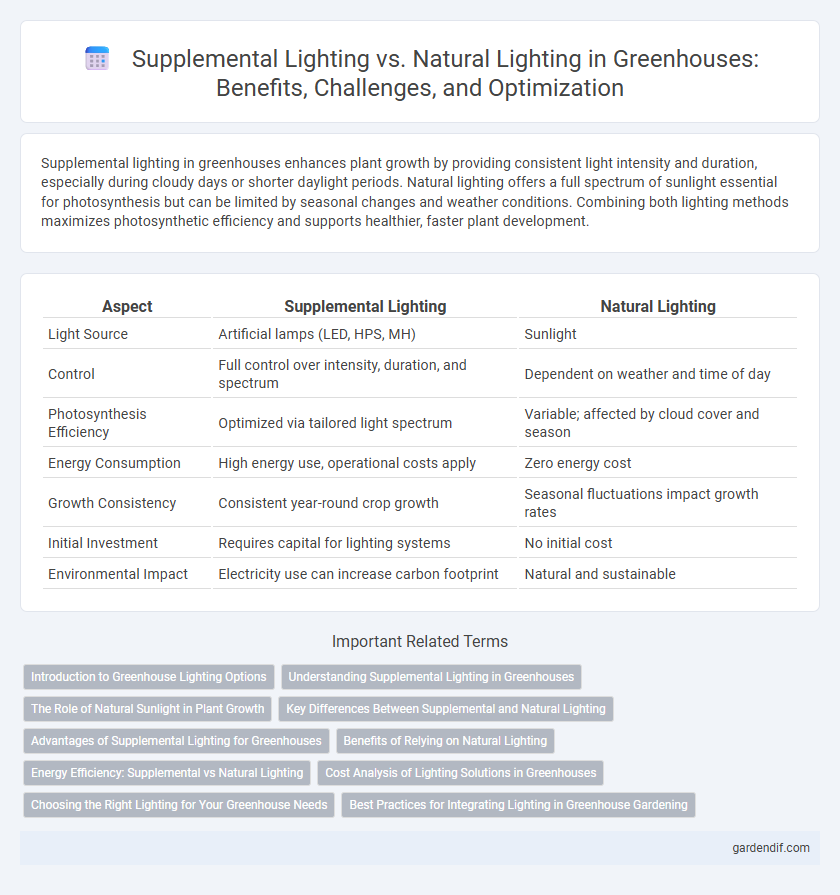
Supplemental Lighting vs Natural Lighting Illustration
Supplemental lighting in greenhouses enhances plant growth by providing consistent light intensity and duration, especially during cloudy days or shorter daylight periods. Natural lighting offers a full spectrum of sunlight essential for photosynthesis but can be limited by seasonal changes and weather conditions. Combining both lighting methods maximizes photosynthetic efficiency and supports healthier, faster plant development.
Table of Comparison
| Aspect | Supplemental Lighting | Natural Lighting |
|---|---|---|
| Light Source | Artificial lamps (LED, HPS, MH) | Sunlight |
| Control | Full control over intensity, duration, and spectrum | Dependent on weather and time of day |
| Photosynthesis Efficiency | Optimized via tailored light spectrum | Variable; affected by cloud cover and season |
| Energy Consumption | High energy use, operational costs apply | Zero energy cost |
| Growth Consistency | Consistent year-round crop growth | Seasonal fluctuations impact growth rates |
| Initial Investment | Requires capital for lighting systems | No initial cost |
| Environmental Impact | Electricity use can increase carbon footprint | Natural and sustainable |
Introduction to Greenhouse Lighting Options
Greenhouse lighting options include supplemental lighting and natural lighting, each playing a crucial role in plant growth optimization. Supplemental lighting extends photoperiod and enhances light intensity during low natural light conditions, using technologies such as LED, HPS, and fluorescent lights. Natural lighting relies on sunlight diffusion through greenhouse structures, offering energy-efficient illumination but varying with weather and seasonal changes.
Understanding Supplemental Lighting in Greenhouses
Supplemental lighting in greenhouses enhances photosynthesis by providing consistent light intensity when natural sunlight is insufficient, especially during cloudy days or shorter winter periods. Modern LED grow lights offer energy-efficient, spectrum-tailored illumination that supports specific plant growth stages, improving crop yield and quality. Integrating supplemental lighting with natural light optimizes plant development cycles, ensuring stable production regardless of external weather conditions.
The Role of Natural Sunlight in Plant Growth
Natural sunlight plays a crucial role in plant growth by providing a full spectrum of light that supports photosynthesis and regulates plant development cycles. Its intensity and quality vary throughout the day and across seasons, enhancing chlorophyll production and energy conversion in plants. While supplemental lighting can extend growing hours and improve light uniformity, natural sunlight remains the primary driver for healthy and robust plant growth in greenhouses.
Key Differences Between Supplemental and Natural Lighting
Supplemental lighting in greenhouses provides consistent light intensity and spectrum tailored for optimal plant growth, unlike natural lighting which varies based on time of day, weather, and season. Supplemental lighting extends photoperiod and compensates for low natural light, enhancing photosynthesis and crop yield especially during winter or cloudy days. Natural lighting is cost-effective and sustainable but lacks the controlled environment benefits, making supplemental lighting essential for maximizing productivity and ensuring year-round plant development.
Advantages of Supplemental Lighting for Greenhouses
Supplemental lighting in greenhouses enhances plant growth by extending photoperiods and increasing light intensity, which improves photosynthesis efficiency and crop yields. It enables year-round cultivation regardless of seasonal or weather fluctuations, providing a consistent light source that natural lighting alone cannot guarantee. Supplemental lighting also allows for precise control over light spectrum and duration, optimizing plant development and improving quality.
Benefits of Relying on Natural Lighting
Relying on natural lighting in greenhouses enhances plant growth by providing a full spectrum of light that optimizes photosynthesis and improves crop quality. It reduces energy costs significantly, minimizing the need for supplemental electric lighting and lowering greenhouse operational expenses. Natural lighting also supports environmental sustainability by decreasing reliance on fossil fuels and reducing carbon emissions associated with artificial lighting systems.
Energy Efficiency: Supplemental vs Natural Lighting
Supplemental lighting in greenhouses offers consistent light levels independent of weather, optimizing plant growth during low natural light periods but increases energy consumption due to electricity use. Natural lighting relies on sunlight, providing a free and environmentally friendly energy source, yet its variability can limit photosynthesis efficiency during cloudy days or short daylight hours. Balancing supplemental and natural lighting enhances energy efficiency by reducing electricity costs while maintaining optimal light intensity for crop productivity.
Cost Analysis of Lighting Solutions in Greenhouses
Supplemental lighting in greenhouses incurs higher initial installation and operational electricity costs compared to reliance solely on natural lighting, but it enables extended photoperiods and improved crop yields. Natural lighting offers zero energy cost but depends on geographic location and seasonal variations that limit light availability and consistency. Cost analysis must balance energy expenses of LED or HPS supplemental systems against potential revenue gains from accelerated plant growth and higher-quality produce.
Choosing the Right Lighting for Your Greenhouse Needs
Supplemental lighting in greenhouses enhances plant growth by extending photoperiods and increasing light intensity, crucial during low natural light conditions. Natural lighting offers cost-effective, full-spectrum illumination but may be inconsistent due to weather or seasonal changes. Selecting the right lighting involves assessing crop type, growth stage, geographic location, and energy costs to optimize photosynthesis and yield.
Best Practices for Integrating Lighting in Greenhouse Gardening
Combining supplemental lighting with natural lighting in greenhouse gardening maximizes plant growth by ensuring consistent light intensity and photoperiod control. Utilizing LED grow lights tailored to specific crop light spectrum requirements enhances photosynthesis efficiency while reducing energy consumption. Position supplemental lights strategically to avoid shading and complement the natural sunlight, optimizing overall light distribution and crop yield.
Supplemental Lighting vs Natural Lighting Infographic

 gardendif.com
gardendif.com